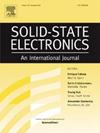直流断路器用反向阻断二极管晶闸管特性评价
IF 1.4
4区 物理与天体物理
Q3 ENGINEERING, ELECTRICAL & ELECTRONIC
引用次数: 0
摘要
本文对直流断路器用反向阻断二极管晶闸管的快速关断能力和串联特性进行了评价。在Sentaurus TCAD中模拟了RBDT的关断操作机制。此外,还讨论了结构参数和载流子寿命对RBDT瞬态特性的影响。RBDT在关断过程中电流分布均匀,表明发生关断故障的可能性很小。通过减少P基厚度、掺杂浓度和载流子寿命而不影响导通特性,可以实现快速的关断速度。通过实验研究了该电路的快速关断能力和串联特性。结果表明,RBDT可以在几微秒内关闭。此外,各RBDT之间的电压分配与击穿电压成正比,说明可以拆除电压平衡设备。此外,RBDT可以在低电压条件下(25 V)接通,开关损耗低。优异的器件性能使RBDT成为直流断路器应用的潜在候选者。本文章由计算机程序翻译,如有差异,请以英文原文为准。
Characteristics evaluation of reverse blocking diode thyristor for DC circuit breaker
In this paper, the fast turn-off ability and series characteristics of reverse blocking diode thyristor are evaluated for DC circuit breakers. The turn-off operation mechanism of RBDT is simulated in Sentaurus TCAD. Besides, it is discussed the influence of the structure parameter and carrier lifetime on the transient characteristics of RBDT. The current distribution during the turn-off process of RBDT is uniform which indicates a small possibility of the occurrence of the turn-off failure. A fast turn-off speed could be achieved by the reduction of the P base thickness, doping concentration and carrier lifetime without compromising the turn-on characteristics. The fast turn-off capability and series characteristics are also investigated by experiments. It is shown that RBDT could be turned off within several microseconds. Besides, the voltage allocation between each RBDT is proportional to the breakdown voltage, which manifests the voltage balance equipment could be removed. Besides, RBDT can turn on at low voltage condition (25 V) with low switching loss. The excellent device performance makes RBDT a prospective candidate for DC circuit breaker applications.
求助全文
通过发布文献求助,成功后即可免费获取论文全文。
去求助
来源期刊

Solid-state Electronics
物理-工程:电子与电气
CiteScore
3.00
自引率
5.90%
发文量
212
审稿时长
3 months
期刊介绍:
It is the aim of this journal to bring together in one publication outstanding papers reporting new and original work in the following areas: (1) applications of solid-state physics and technology to electronics and optoelectronics, including theory and device design; (2) optical, electrical, morphological characterization techniques and parameter extraction of devices; (3) fabrication of semiconductor devices, and also device-related materials growth, measurement and evaluation; (4) the physics and modeling of submicron and nanoscale microelectronic and optoelectronic devices, including processing, measurement, and performance evaluation; (5) applications of numerical methods to the modeling and simulation of solid-state devices and processes; and (6) nanoscale electronic and optoelectronic devices, photovoltaics, sensors, and MEMS based on semiconductor and alternative electronic materials; (7) synthesis and electrooptical properties of materials for novel devices.
 求助内容:
求助内容: 应助结果提醒方式:
应助结果提醒方式:


